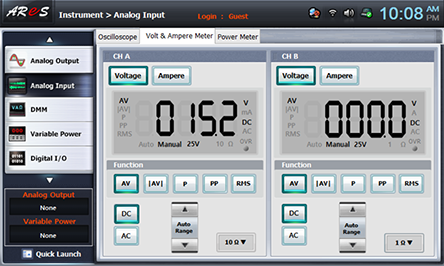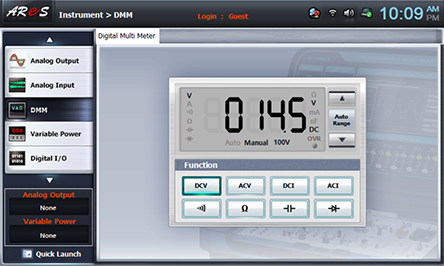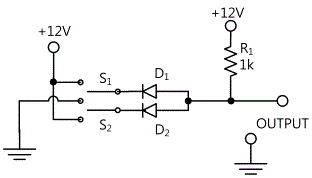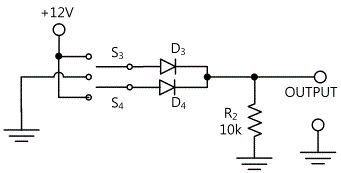PART13Fundamental Logic Circuit
Experiment Purpose
- 1.Experiment the logic concept of basic gate by diode.
- 2.Understand the characteristics of AND, OR, XOR gates through experiment.
- 3.Investigate NOT logic gate such as NAND, NOR, NOT.
Experiment 1 :Diode Logic Circuit
Theory
Digital logic function can be realized using diode and resistance. Fig.13-2(a) shows OR gate. "0" means 0V and "5" means + voltage(+5V). Here, when VA = 0V(logic 0) VB = 0V(logic 0) only, the output VC = 0V(logic 0). If either VA or VB(or both) is high level, the corresponding diode is conducted and the output becomes high level(logic 1). Therefore, it follows truth table of fig.13-2 (b).
However, this diode logic gate has problems. If one among inputs is high level, that is, +5V, the output will be high level. However, the size becomes about 4.3V which is smaller than +5V because of the voltage drop(=0.7V) of diode. This value is near +5V so it can be expressed precisely as logic 1. However, as in complex digital system, if several of these gates are connected in series, the voltage drops of diodes are combined so the level could become too low to be read as 1. In this case, this problem can be solved by using amplification element such as transistor to restore the value properly.
Fig.13-3 (a) shows AND gate having 2 inputs. The truth table having 2 inputs is as fig.13-3(b). "0" means 0V and "1" means +5V so AND gate function can be realized. Here, if one among two inputs is low level, the corresponding diode is conducted so the output becomes low level. When only two inputs are all high level, two diodes are operated as open circuit and the voltage same as power voltage appears at the output.
Due to the voltage drop of diode, the output voltage at low level state is not 0V but about 0.7V. This level drop is similar to that of OR gate, and can be solved through level restoration circuit.
Experiment Process
1. As in fig.13-14, compose an AND gate circuit at Circuit-1 of M-13.
2. If the switch of the circuit is opened, it is connected to GND and it means low level, and if it is connected to 12V, it means high level. Adjust the switch following table 13-1 and record the output value. If the light of LED-1 is on, record 1 and if it is off, record 0.
3. As in fig.13-15, compose an OR gate circuit at Circuit-1 of M-13.
4. Adjust the switch following table 13-1 and record the output value. If the light of LED-2 is on, record 1 and if it is off, record 0.
tab1Experiment 13-1.1 Diode Logic Circuit Experiment (In Circuit-1 of M13, compose circuits as in fig.13-4, 5.)
Diode AND Circuit
1.Connection
1.Power connection is internally connected.
2.Measuring Instrument Connection
Input Voltage Measurement
Connect between 1a terminal of Circuit-1 and A+ terminal of Signal Input CH A on the front panel with red line, and between 1f terminal and A- terminal with black line.
Connect between 1b terminal and B+ terminal of CH B with red line, and between1f terminal and B- terminal with black line.
Output Voltage Measurement
Connect between 1e terminal of Circuit-1 and High terminal on the front panel of Multimeter with red line, and between 1f terminal and Low terminal with black line.
2.Wiring Diagram
3.Measurement
- 1In Circuit-1 of M13, compose a circuit as in fig.13-3.
Measure the voltage applied to diode D1, D2 input using switch S1 and switch S2 and operating as “H”, “L” in table 13-1, record the output as “1” when LED 1(red) is on, and as “0” when off. Measure and record the voltage of each case.
(When the SW is located at “L”, it is connected to GND, which is 0 potential. And when it is located at “H”, +15V potential is connected to the circuit.) - 2Input Voltage Measurement: Choose analog input at Touch LCD panel, choose Volt & Ampere Meter tab, click , , at CH A and CH B and record the measured output voltage in the relevant column of table 13-1. (CH A = S1, CH 2 = S2)
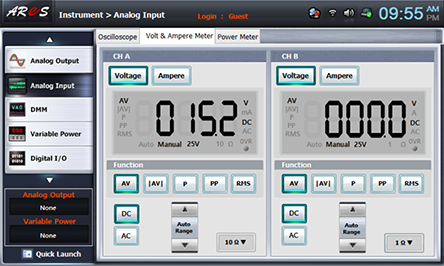
- 3Output Voltage Measurement: Choose dmm at Touch LCD panel, click and record the measured output voltage in the relevant column of table 13-1.
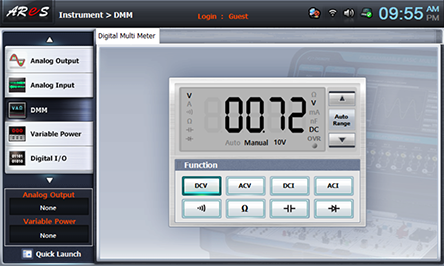
Diode OR Circuit
1.Connection
1.Power connection is internally connected.
2.Measuring Instrument Connection
Input Voltage Measurement
Connect between 1c terminal of Circuit-1 and A+ terminal of Signal Input CH A on the front panel with red line, and between 1f terminal and A- terminal with black line.
Connect between 1d terminal and B+ terminal of CH B with red line, and between1f terminal and B- terminal with black line.
Output Voltage Measurement
Connect between 1g terminal of Circuit-1 and High terminal on the front panel of Multimeter with red line, and between 1f terminal and Low terminal with black line.
2.Wiring Diagram
3.Measurement
- 1In Circuit-1 of M13, compose a circuit as in fig.13-4.
Measure the voltage applied to diode D3, D4 input using switch S3 and switch S4 and operating as “H”, “L” in table 13-1, record the output as “1” when LED 1(red) is on, and as “0” when off. Measure and record the voltage of each case.
- 2For input/output voltage measurement, execute [Diode AND Circuit]>3. Measurement>2), 3) and record the result in table 13-1. (CH A = S3, CH 2 = S4)
